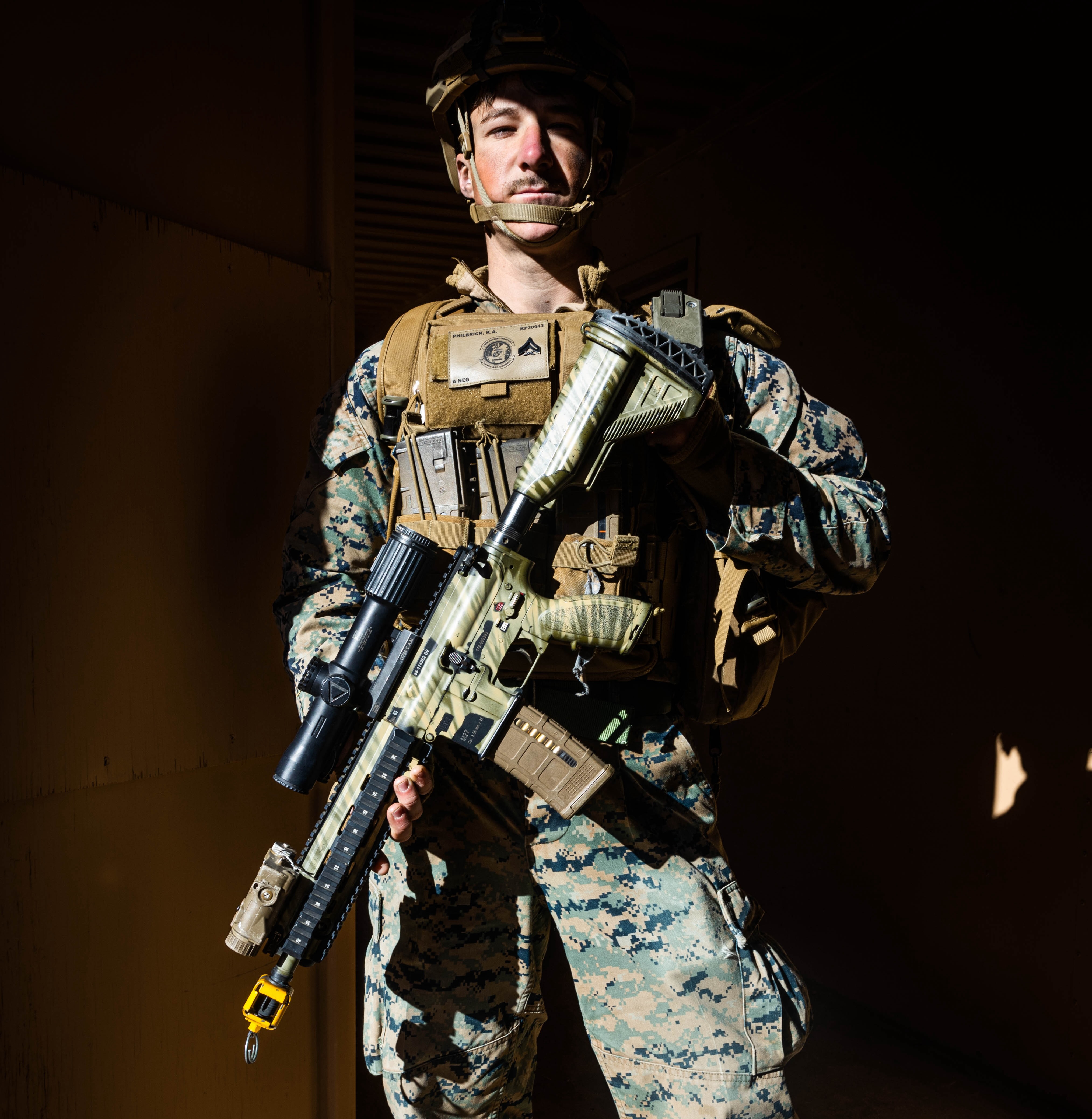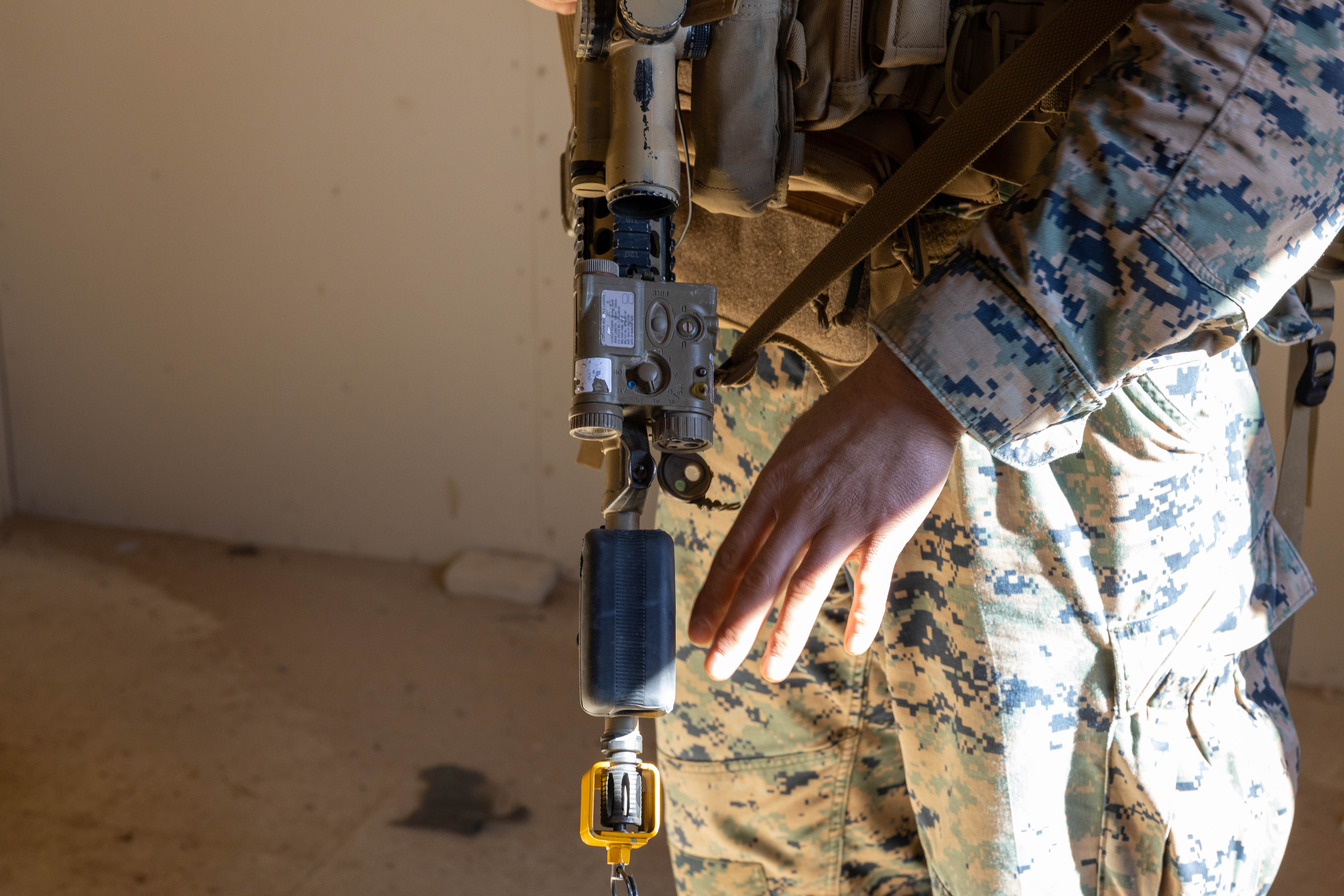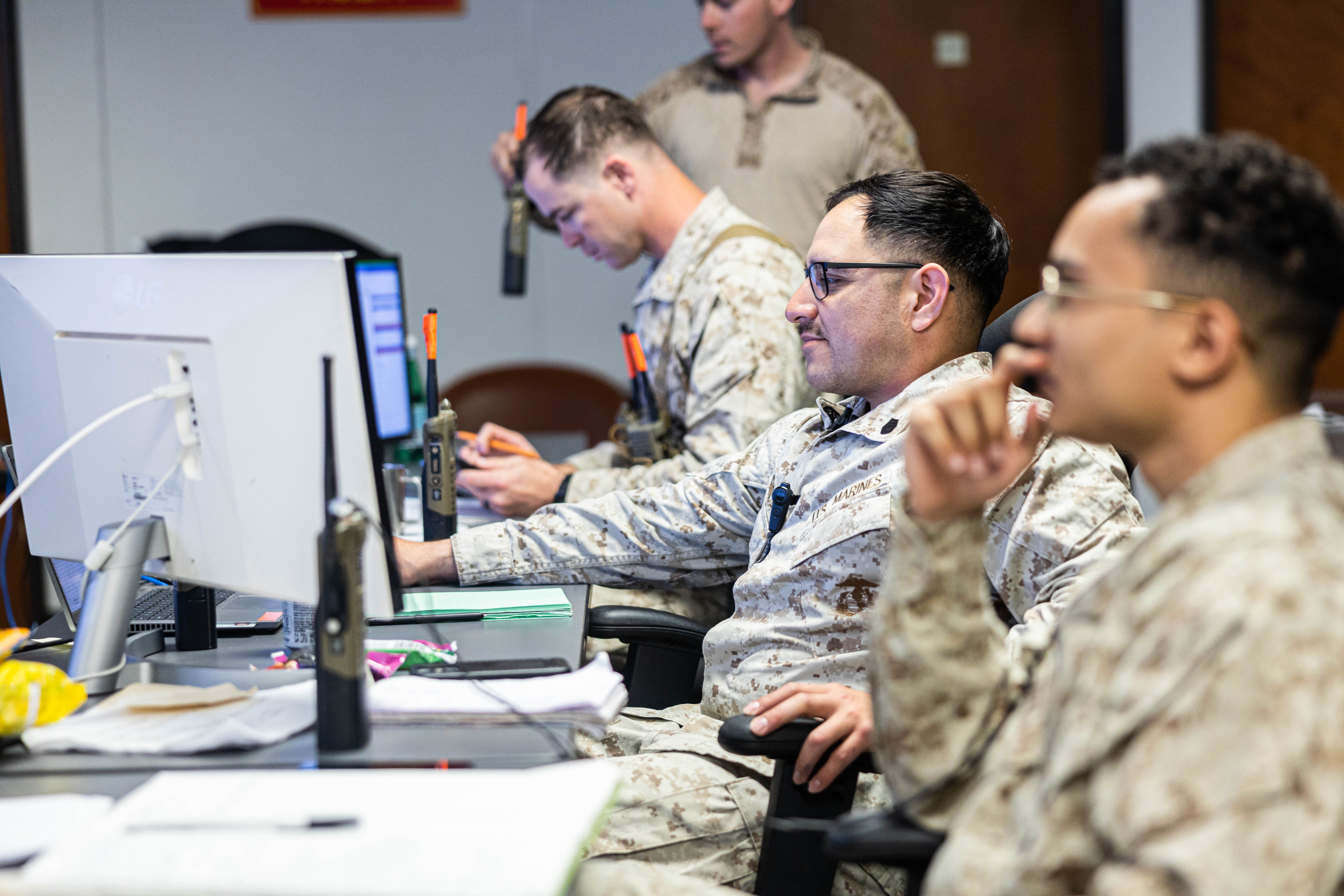
TWENTYNINE PALMS, Calif. – All eyes were on a set of monitors in a crowded conference room as a half-dozen briefers summed up the action from the night before.
Several Marine Corps battalions had gotten into pitched battle with an adversary force that had maneuvered its way into Marine Corps Air Ground Combat Center’s Range 220, a combat town that served as a key city in a wargame scenario last month.
“They’re at a standstill, looking at each other across the canal,” a lieutenant colonel told the exercise commander during the morning briefing, which was held in a small building at Camp Wilson as several dozen staff officers, exercise controllers and planners listened intently.
It was Day 2, and the briefing provided a snapshot of the force-on-force, simulated battle happening across the Marine Corps’ desert training base. The large-scale, service-level exercise involved 6,700 Marines from West Coast and East Coast bases, with 7th Marine Regiment and 11th Marine Regiment leading the exercise and adversary forces, respectively. Such recurring Marine air-ground task force warfighting exercises, or MWXs, have evolved into multidomain wargames that include free-play scenarios with forces on the ground and in the air fighting adversaries, both real and in a computer-driven simulated environment.
Marines long have faced off in simulated battles, but this MWX was different. Some 2,100 Marines wore new live-tracking sensor technology, and mobile 4G networks relayed as-it-happens data to exercise planners, training officials and unit commanders. The tech proof-of-concept marked its first large-scale use to expand realism and encourage more free play in the Marine Corps’ force-on-force combat training. It is a top priority for Marine Corps Training and Education Command and its “Project Tripoli” training modernization campaign to prepare Marines for future conflicts envisioned in its Force Design doctrinal concepts.
That new tech is the Marine Corps Tactical Instrumentation System, with warfighter-worn, weapon-borne and vehicle-borne sensors that collect or track location, weapon engagement and battle effects. The idea is that tracking sensors and weapons-specific targeting devices inject better realism into exercises than existing, less-accurate laser tag or controller-driven – the “bang, you’re dead” – training. The networked battlefield expands into a larger, constructed, all-domain environment that ties in other combat forces, weaponry and systems, whether real, simulated or computer-created.
Under a contract with TECOM and Marine Corps Systems Command’s Program Manager for Training Systems, Saab Inc. developed and tailored MCTIS from its existing gaming and military training technologies. It also incorporated mobile networks in portable container systems that provide realistic, force-on-force engagements on any range, anywhere.
“It’s designed to be training at the point of need,” David Rees, Saab’s director of training and simulation, told USNI. “We provide all the support for it.”
The MCTIS force-on-force training system will replace the existing FoF capability of Multiple Integration Laser Engagement System gear on the Instrumented-Tactical Engagement Simulation Systems II platform, or I-TESS. The next-gen system, officials say, will improve warfighting skills and lethality by letting Marines fight with their organic infantry weapons and combat systems on both offense and on defense in unscripted, free-play fighting.
“It used to be where they were solely focused as being the adversary. But we have allowed that to transition to not be a templated enemy set for the exercise force to go against, but to be a Marine Corps force against a Marine Corps force,” said Maj. M.G. Spiese, operational planner with Marine Air-Ground Task Force Training Command at the Twentynine Palms combat center. “They’re not fighting as a pacing threat or another templated enemy. They’re fighting with their tactics, techniques and procedures … against another living, thinking enemy.”
A unit outfitted with the MCTIS sensors and trackers can step into a live, virtual or constructive exercise in the role as the exercise force, the adversary or both. After initial conceptual tests in 2022 and 2023, “this is the first time we have been able to do both offense and defense operations,” Spiese said. While 7th Marines often goes up against units at their desert home base for training, the regiment isn’t a dedicated, permanent adversary force like the Army’s at the National Training Center at Fort Irwin, Calif.
Day Two of the simulated MWX conflict saw exercise and adversary forces tally both wins and losses, with casualties on both sides. “There is always interesting outcomes when it comes to the free-play of the force-on-force portion,” Spiese said. Whichever side a Marine is on, he said, “we’re making sure that… you’re building readiness, it’s realistic, and it’s preparing you for combat.”
What’s in the Kits

The battalion kits of the MCTIS force-on-force training system include company kits with individual gear sets to equip Marines and, for now, most of their organic weapons and some unit vehicles. Each individual kit includes a chest harness, helmet “halo” harness, personal computer unit (PCU), radio, GPS antenna, laser detectors, two batteries and battery pack. Each lithium-ion battery lasts up to 120 hours before recharge.
“This is designed so each individual Marine can adjust this equipment to whatever their pack is,” Rees said. The helmet harness, worn over one’s Kevlar, collects posture information so “we know if a Marine is standing, is prone, is kneeling,” he said, and helps determine the level of injury or casualty if hit.
Speakers in the PCU – it’s the size of a deck of cards – relay information and provide sensory feedback. If a Marine is 100 meters from a building struck by a 155-mm round, their PCU “will tell you ‘heavy indirect fire, 100 meters northwest.’ So you actually get feedback,” he said.
The wallet-sized small-arms transmitter (SAT) is attached to each weapon and matched to the weapon type. Currently, SATs are available for individual service weapons, but future plans include vehicle-mounted weapons, he added.
“It’s extremely accurate,” Rees said of Saab’s laser system, and more discerning than the Marines’ existing MILES. “We will kill the target that we are aiming at.” A Marine aligns the SAT on the weapon using a small kit card. “It can take 10 seconds, and that’s a huge piece of getting teams out the door quickly,” he added.
Digital data from sensors and detectors on individuals, vehicles and buildings coalesce into an automatic running tally of hits, misses, casualties and kills on both sides, and the resulting impacts factor immediately into the collective battle scenario. “The system calculates, would this round have hit?” Rees said, and “the ballistic simulation gives you a realistic battlefield effect.”
MCTIS includes vehicle sensor sets that track location, movement and status and building sensors that track impacts and activity; mobile network nodes; a portable command-and-control exercise control site with five workstations, radio base station and 30-meter mast; and storage and workshop facilities.
Marines Get First Look

Marines like the realism and realistic feedback that MCTIS provides.
“It’s a lot different than playing the games … where you can just run around and shoot at different people and there’s no impact. They can keep running,” said Lance Cpl. Ian Mclaughlin, a rifleman with 2nd Battalion, 6th Marine Regiment, 2nd Marine Division from Camp Lejeune, N.C.
“But with this system, it’s really good, because you can hear like snapshots. It’ll crack at you with the speaker here if you’re getting shot at,” Mclaughlin said in a Marine Corps news video about the training. It’ll down your weapon system, if you get shot at. If you’re critically wounded, it’ll disable your weapon system so you can’t affect anybody else. So you’re completely out of the fight.”
Weapons sensors were “pretty phenomenal,” he said. The portable speaker, attached to the shoulder harness, “will give you the meters and the cardinal direction of where it’s coming from. So it’s really, really good, realistic training.”
Saab representatives outfitted his company with the gear and gave Marines a 30-minute class. “Once it’s on and once you have the battery in it, you don’t have to think about it. It’s just there,” Mclaughlin said. The sensors know “when you get shot or if you get wounded by shrapnel. It’ll tell you right leg, left leg.”
His battalion, part of the MWX adversary force, wore the gear during a prior 10-day field exercise. The “only downside” was the thick straps of the harness were bothersome, he said. “They do kind of hurt after a couple of weeks of wearing them. But other than that, the system is pretty good.”
Second Lt. Nicholas Molineaux likes the system and hopes it gets streamlined. “I’d like to see if we can get the same kind of system (be) less bulky” and with attachments to their existing gear “so it doesn’t get in the way so much,” Molineaux, executive officer with Headquarters Co., 2/6, said in the news video. “I think we’re moving in the right direction with it,” he said, adding “it can be very useful for training.”
The junior officer found the debriefing tool provided a great bird’s-eye view of fighting and maneuvers on the ground. “It’s pretty useful during AARs, being able to battle track where everybody was moving throughout the duration of the operation,” he said. The system “provides a really kind of clear, in-depth picture of the different forces moving throughout the battlespace… It’s very accurate down to like a 10-digit grid, even buildings where you were.”
Saab will consider modifications based on Marines’ feedback from the recent field training. Ease of use is as important as its training value to ensure units use the system rather than let it collect dust in the warehouse, company reps said.
“We’ll accommodate exactly what they’re talking about, because we want to make sure the form and fit hits the mark,” James McArthur, Saab’s site lead, told USNI.
McArthur, a former infantry battalion commander and retired colonel, said one Marine asked about shifting the PCU from the left shoulder to the right upper chest vest or elsewhere so it’s out of the way of a left-handed shooter. It’s important to get the MCTIS right, he said. “If I’m not able to wear my kit in the manner of how I’m going to combat,” he noted, “I’m not going to wear it.”
Instant Feedback, Faster Review

Kits include handheld tablets that give unit commanders live situational awareness of the battlefield and tablets for “Coyote” exercise controllers and observers with the Tactical Training and Exercise Control Group so they can live-track actions and pull data and analyses for after-action reviews.“When you have the common operating picture from the technology pumping up on the network, something that would take 60 to 90 minutes is instantaneous, and we don’t have to wait,” Spiese said, and “you can see it live.”
“We have the ability to upload the ORBAT, the order of battle, so essentially we can get … individual Marines’ names, and so forth,” said Michael Jelensky, a former Marine “Coyote” and deputy site lead for Saab.
During training, the tablet allows Coyotes “to call in fires, send fire missions out,” Jelensky said. “They also have the ability to bring people back to life” to sustain the training value if casualties get high.
The debriefing tool frees up exercise controllers from tracking every action and battle “so they can focus on the evaluation and the feedback,” Spiese said. Coyotes have had “to adjudicate who shot John. When you have the system that does that for them, you don’t have to worry.” Moreover, he said, data automation will reduce human errors and identify trends.
And when the battle is over, Marines won’t have to wait for the Coyotes to scrutinize combat actions and decision-making. Rather, data collected and uploaded automatically through mobile nodes into the battlefield network are analyzed and available anytime on their laptops or tablets.
The digital data inputs from all participating units and domains provide a wider, clearer picture of what’s happening on the ground, in the air or virtually. The after-action tool helps “communicate to all of them where they were in time and space,” said Lt. Col. Jesse Attig, a modeling and simulation officer with MAGTF Training Command at Twentynine Palms. “It’s almost like we can all distributively look over this kind of AAR tool and we can understand it. If we don’t have all that stuff connected, then we’re not doing that,” Attig said.
Maj. James Horton, TTECG’s assistant operations officer, said the tool has “a lot of potential … not just in the force-on-force but possibly as we get into” live-fire training and assist with kill-chain mapping.
Units that travel here for a month of field training in the desert don’t have “a lot of time to digest information, so being able to give the exercise forces something to take away and look back on later is important to us,” Horton said. “Once we get it [full operational capability] with more towers and everything else, I think there’s a lot of goodness that’ll come of this,” he added.
Four battalion kits are being fielded at Twentynine Palms, the first of five sites where Saab will deploy the supporting infrastructure, Rees said. Two kits are expected to be fielded this spring at Camp Pendleton, Calif., and followed by two battalion kits at Camp Lejeune, N.C., and one battalion kit each at Marine Corps Base Hawaii and Quantico Marine Corps Base, Va.
If the service issues an “indefinite quantity, indefinite delivery” contract, “we may look at overseas sites, including Okinawa and Guam,” said Rodney Edwards, Force-on-Force Training Systems portfolio manager at TECOM. If there’s more demand after initial fielding, he said, “we’ll see exactly how much the fleets are using it, and that’ll signal to us if there’s more that we need to procure.”





